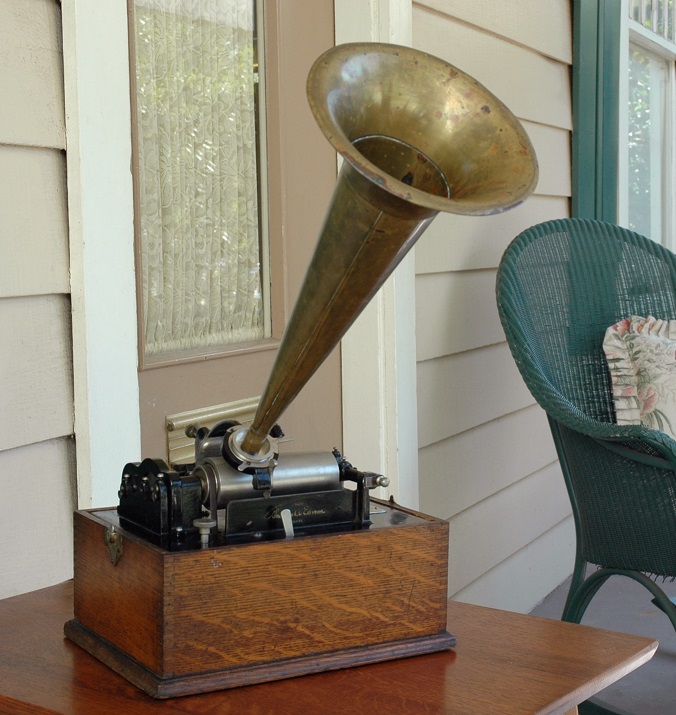
Today, electronic technology is intertwined with almost every aspect of music performance, recording, distribution and marketing. It all began with the Edison cylinder machine, a purely mechanical technology for recording and playing back music. The photo above shows an Edison Standard Phonograph from 1898, described in more detail at the Antique Phonograph Society web site. Your can watch a demo of a similar machine here, and listen to many other old cylinder recordings at the UCSB Cylinder Audio Archive. The Vulcan Cylinder Record Company still makes cylinder recordings the old way, by a purely acoustic process. Could it be that mechanical recordings like these were made accidentally in the distant past? Probably not, but there's an old science fiction story based on this idea.
Weeks 14-15 Highlights
In weeks 14 and 15 we will learn about analog and digital signals, digital sampling, binary numbers, and channel capacity.
Reading: Chapters 16 and 20 in Hartmann.
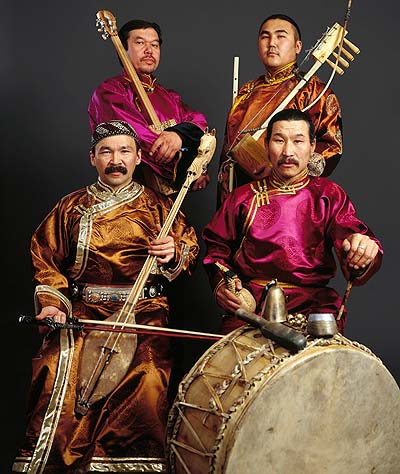
The musical group Huun-Huur-Tu from Tuva, in central Asia (watch them here and here). Tuva is famous for a vocal technique known as throat singing or overtone singing. Ordinary vowel sounds are created by resonances in the vocal tract called formants. Throat singing works in basically the same way, but the resonances are sharper and they are carefully manipulated to create a second melody above a low fundamental pitch. Other cultures around the globe have developed related vocal techniques. Once upon a time, there was even a throat singing cowboy (listen to Arthur Miles here and here). Mark van Tongeren gives a throat singing lesson here.
Weeks 12-13 Highlights
In week 12 we cover wind instruments, including woodwinds and a little about their history. Week 13 is all about the human voice.
Reading: Hartmann chapters 22, 23, 24.
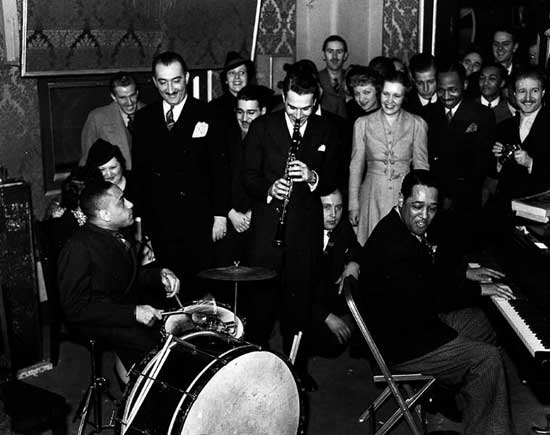
The modern drum kit was invented by jazz drummers in the 1920s and '30s. One of the greatest innovators was Chick Webb, shown above with fellow jazz giants Artie Shaw and Duke Ellington. Warren 'Baby' Dodds, who played with Joe King Oliver, Jelly Roll Morton and Louis Armstrong, is often credited with developing the feel of the modern jazz ride cymbal pattern. His disciple, Gene Krupa (watch) popularized the drum solo in the swing era, and was an important influence for many rock drummers. Fast-forward to 2013, and check out Stanley Davis.
Weeks 9-11 Highlights
Musical scales are sequences of pitches with definite frequency ratios between them. In week 9 we will cover intervals, note names, scales, and two different tuning systems: 12-tone equal tempered tuning and just tuning. In week 10 we'll start on hearing and loudness, and then in week 11 cover room acoustics, and start on percussion and string instruments.
Reading: Posted lecture slides for scales and tuning, then Hartmann chapters 11,12, 15, 25, 26.

To many, he was the greatest American musician of the 20th century. Louis Armstrong (listen) started out playing the cornet, but switched to the trumpet around 1930. His Hot Five and Hot Seven tracks (1926-28) are often cited as the most influential jazz recordings ever made. Besides playing the trumpet, Armstrong was a highly influential vocalist who invented the scat singing style (listen to Heebie Jeebies). At age 63, Armstrong knocked the Beatles off the top of the Billboard chart with Hello, Dolly.
Weeks 7-8 Highlights
In week 7 we will discuss sound intensity and decibels. In week 8 it is time for the midterm. After that, we will learn about musical scales.
Reading: Chapter 10 of Hartmann. Musical scales will be covered in the posted lecture slides.
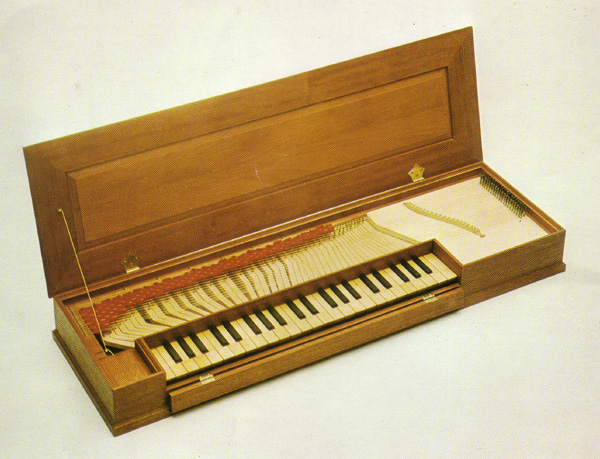
There are hundreds of different kinds of string instruments. The clavichord, shown above, has the simplest mechanism of all keyboard instruments, and some are small enough to play on your lap. Watch clavichord maker Sigurd Sabathil play one of his instruments. Other less-familiar strings include the fretted viols, the hammered dulcimer, and the hurdy gurdy (watch Matthias Loibner). Strings have attracted many spectacular performers, from Nicolo Paganini, the original shredder, to the astounding Anna Vidovic.
Weeks 5-6 Highlights
In week 5 we will learn about standing waves in tubes, which is the basis for understanding woodwinds and organ pipes. In week 6 we will discuss Fourier analysis of periodic waveforms.
Reading: Chapters 8 and 9 of Hartmann.
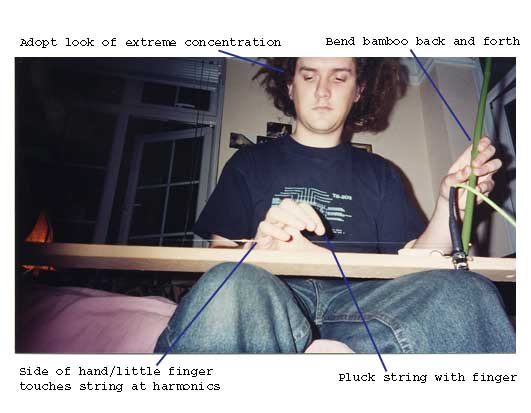
In homelabs #2 and #3 we will experiment with the monochord, a single vibrating string. Following the Pythagoreans, our focus will be on using the monochord to study the physics of musical intervals. However, many cultures around the globe have developed monochord instruments for musical expression. The photo above shows Dan Stowell playing his homemade electric monochord, which he patterned after the dan bau, a traditional Vietnamese instrument. Watch Jason Nguyen play the real dan bau, together with master lutenist Pham Duc Thanh. Other monochord instruments include the Brazilian berimbau (watch), the Japanese ichigenkin, the bizarre European tromba marina, and the African-American diddley bow (Listen here and watch here).
Weeks 3-4 Highlights
In week 3 we will introduce sound waves and start a series of homelab experiments with the monochord. In week 4 we will learn about wave interference, beats, and standing waves.
Reading: Chapters 5,6 and 7 of Hartmann.
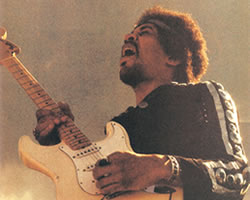
Vibrating strings have been used by humans to make music for at least 5000 years. In acoustic string instruments, such as the acoustic guitar, the vibrations of the string drive a soundboard which then creates sound waves in the surrounding air. The electric guitar works on a completely different principle: the string causes changes in a magnetic field, and the varying magnetic field induces an electrical signal in a coil of wire. The signal is then sent over a wire cable to an amplifier and loudspeakers. In the 1960s, the great Jimi Hendrix expanded the sound palette of vibrating strings by his aggressive use of feedback, distortion and other electronic effects. Listen here. The vibration of strings is one of the most important topics we will explore in this course.
Weeks 1-2 Highlights
Welcome to Physics 1240! Read the Syllabus and Calendar tabs above to find out what we will be doing and how the course is organized. Our first class is on Tuesday, August 27 at 12:30 pm in Duane G1B30. The textbook is Principles of Musical Acoustics, by William Hartmann. Click here to download a copy (link only works on campus or with a VPN connection to campus). We will be using the CUClickers system in this course. You must register your clicker so that we can associate your clicks in class with your name. Instructions for registering are here. During the first week you should download and install Raven Lite, a computer program for analyzing sounds. See the software tab above for more info. Please also have a look at our Canvas site, which will be used for completing your homework assignments, to view homework solutions, to upload homelab assignments and view solutions, and to view clicker and exam solutions.
Reading: Chapters 1,2,3 and 5 of Hartmann.
